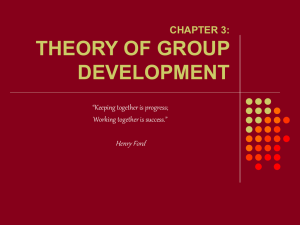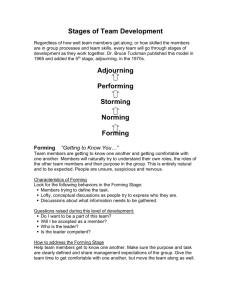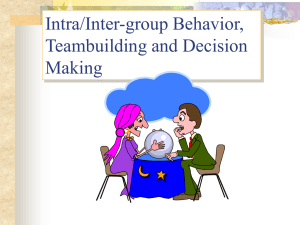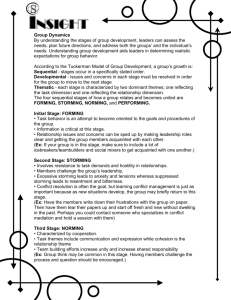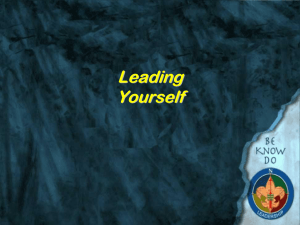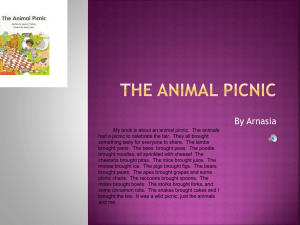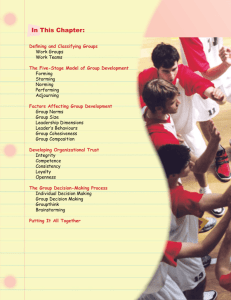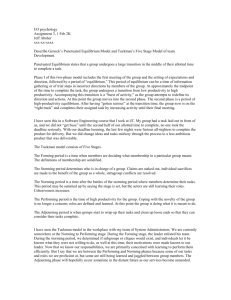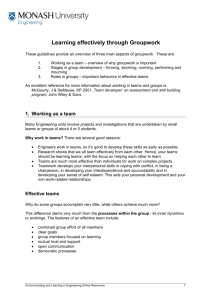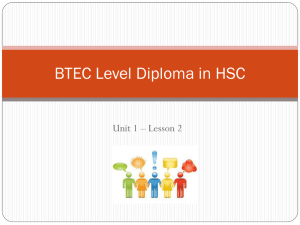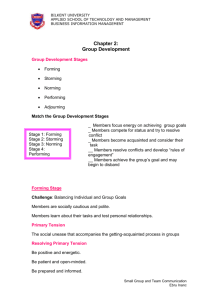THEORY OF GROUP DEVELOPMENT Defining and Classifying
advertisement
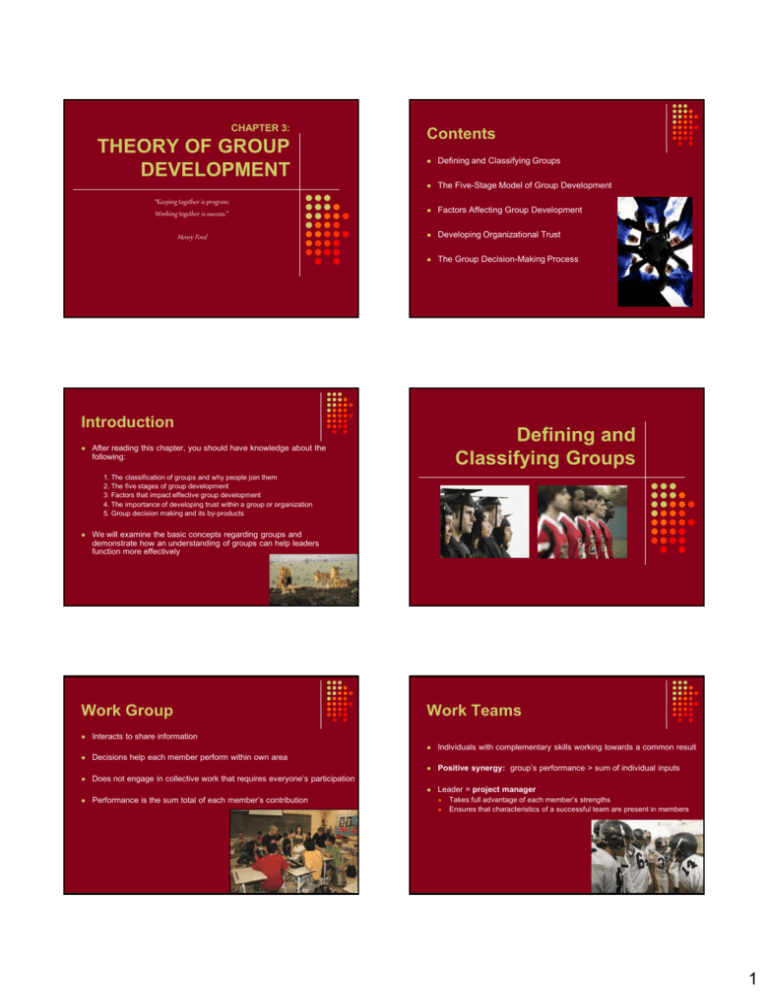
CHAPTER 3: THEORY OF GROUP DEVELOPMENT Contents Defining and Classifying Groups The Five-Stage Model of Group Development “Keeping together is progress; Working together is success.” Factors Affecting Group Development Henry Ford Developing Organizational Trust The Group Decision-Making Process Introduction Defining and Classifying Groups After reading this chapter, you should have knowledge about the following: 1. The classification of groups and why people join them 2. The five stages of group development 3. Factors that impact effective group development 4. The importance of developing trust within a group or organization 5. Group decision making and its by-products We will examine the basic concepts regarding groups and demonstrate how an understanding of groups can help leaders function more effectively Work Group Interacts to share information Decisions help each member perform within own area Does not engage in collective work that requires everyone’s participation Performance is the sum total of each member’s contribution Work Teams Individuals with complementary skills working towards a common result Positive synergy: group’s performance > sum of individual inputs Leader = project manager Takes full advantage of each member’s strengths Ensures that characteristics of a successful team are present in members 1 When a Group Becomes a Team Shared leadership Accountability shared by the team as a whole Responsibility shared equally among members Mission and goals developed by the team itself vs. outside source Continual work vs. at regularly scheduled times Effectiveness measured in team vs. individual outcomes The Five-Stage Model of Group Development Forming Forming Storming Group members: Norming Performing Have just been introduced Familiarizing themselves “Testing the waters” Uncertainty about the group’s purpose, structure, and leadership Adjourning Storming Infighting Quite volatile Norming Development of: Conflict, open rebellion, power struggles Close relationships Cohesiveness and cooperation Group identity Camaraderie Acceptance of the existence of the group but resistance of the constraints Increased organization Conflict over who will lead Development of norms Completion: + Hierarchy of team leadership - Some groups never completely emerge Acceptable standards of behaviour, goals, or values Completion: Solid group structure Recognition of norms 2 Performing Significant task progress being accomplished Coming together well to perform individual functions Team structure completely functional and acceptable Leader’s ultimate goal Adjourning In temporary work teams Assigned task completed Disbandment Wrapping up activities replace task performance Members: Factors Affecting Group Development Group Norms Acceptable standards of behaviour considered appropriate Vary from group to group Leader: Strives to understand norms Ensures that group exerts pressure on members to comply with norms Deviation from norms: Group Size Happy the job has been completed OR Sense of loss of the team camaraderie OR Reforming – begin different project Leader interprets and makes recommendations for positive change Other members punish or correct Leadership Dimensions Effect of size varies depending on the purpose and goals Low Relationship/ Low Task Smaller groups: Larger groups: High Relationship/ Low Task +Make decisions quickly -Less discussion +Bring forth more opinions -Take longer to arrive decision Low Relationship/ High Task High Relationship/ High Task 3 High Relationship/Low Task High Relationship/High Task EXAMPLE: A group meets to plan a corporate picnic. The group members spend some time at their first meeting getting to know each other by introducing themselves and discussing why they volunteered to sit on the picnic committee. Therefore, at this point the relationship of the group is more important than the task at hand, hence high relationship/low task. Works best in forming stage when faced with strict deadline Leader ensures that group is: Working on the task and Moving quickly through the forming, storming, and norming stages EXAMPLE: The leader or chairperson of the corporate picnic committee works on building group relationships but at the same time sets timelines for tasks to be completed for the picnic. To be ready for the event day, the group members must get to work, but they also must get along and work cooperatively to get these jobs done on time. Almost through the storming stage Leader is working with the group on the task as well as building relationships within the group Relationships important to ensure cohesion and complete task on time Low Relationship/High Task EXAMPLE: The picnic committee now knows each other’s strengths and weaknesses and chooses tasks to match individual strengths. The group members work within their assigned roles. Low Relationship/Low Task In the performing stage Leader now offers advice when needed Moving out of the storming stage Group essentially functions on its own Leader works diligently on the task while the group works through the norming stage of development Group members work well together and understand the implications of the task deadline The task has a timeline that must be met May need leader to step in temporarily to bring the group back on track Relationship at a point where members have established their roles and can focus on the tasks Leaders must be prepared to adapt, adjust, and mediate conflict Leader’s Behaviours 1. 2. Task behaviours Relationship behaviours Not only exhibited by the leader, but also by group members when leader is relinquishing control Task behaviours Help keep the group on track and moving towards completing the task at hand Include the following roles: Initiator – generates new ideas and suggests solutions Elaborator/Clarifier – expands on existing ideas and may restate ideas Summarizer – pulls ideas together and ensures consensus Recorder – records details for current and future progress Time keeper – makes sure the group observes time limits and deadlines 4 Group Cohesiveness Relationship behaviours Keep individuals within the group feeling wanted and valuable Following roles and behaviours: + + + + Encourager – makes everyone feel important Gate keeper/Involver – ensures everyone’s opportunity to contribute Mediator – helps keep harmony by suggesting compromises Custodian – checks to ensure that the group doesn’t violate values - Blocker – opposes others’ ideas and gets off topic Joker – is centre of attention and makes fun of others’ ideas Dominator – imposes his own ideas at the expense of others Hidden agenda – fulfills her own personal gains Dependent – depends on others for ideas and opinions The degree to which individual members are attracted to a group and each other Varies between groups Linked to the group’s overall productivity Recommendations for developing cohesiveness: Group Composition Preselected Groups Heterogeneous groups: Smaller size More time spent together “Buying into” the group’s goals Physical isolation Highlight valued status Reward the group members equally Encourage competition with other work groups EXAMPLE: Composed of dissimilar individuals Promotes group conflict More likely to have diverse information and abilities Improved decision making and task completion Within the corporate picnic committee, the Blue’s organize the decorations and entertainment, the Green’s schedule the events and prepare the menu, the Gold’s take meeting minutes and organize the registration, and the Orange’s prepare the games and contests. For team building each personality colour should be represented Depending on the reason for the group’s existence more or less members of a particular colour can be included Organized Like structure & rules Very dependable. Curious Innovative Problem solvers Active Fun loving Adventuresome Developing Organizational Trust Warm & empathetic Strong communication Strive for harmony Group existing prior to the appointment of a leader Leader must make this group work Determine which group members possess which strengths and then promote these Assign tasks to suit each person Organizational Trust Mutual trust among members Present in high-performance teams Fragile Takes a long time to develop Can be easily destroyed Hard to regain once it has been lost Five key dimensions 5 Integrity Honesty and truthfulness Most important when someone assesses another’s trustworthiness Consistency Competence Technical and human relations skills Followers respect the competent leader and trust that person’s ability to carry out his responsibilities Loyalty Predictability, reliability, and good judgment in handling situations Willingness to protect and save face for another person Followers notice if a leader does not practice what he/she preaches One can depend on a person that does not act in his own best interest behind your back Act consistently across situations and treat people equally Openness Overall willingness of a leader to share ideas, information, and feelings freely Suggestions: The Group DecisionMaking Process Tell the absolute truth Be fair with team members Keep your promises Be confident in your role as leader Be consistent in your actions Maintain confidence Practice openness Speak your true feelings 6 Individual Decision Making Advantages: Fast Clearer accountability More consistent decisions Group Decision Making Almost always superior over individual decisions Advantages: When the decision is relatively unimportant and doesn’t require members’ input for success When all the information required is available Group consensus is the optimum Groupthink Desire for consensus overrides the best possible viewpoint for solving the problem Symptoms include: Rationalizing resistance Pressuring of hesitant members Those who question the group opinion remain silent Silence interpreted as “yes” Leads to poor decision making More complete information and knowledge Higher-quality decisions Less efficient because they use up more time and resources to come to an ultimate decision Brainstorming Overcoming pressures to conformity and generating ideas or alternatives Members “freewheel” as many suggestions and alternatives as possible No criticism is allowed Every alternative is recorded Each individual in the group silently and independently ranks different ideas presented The final group decision = solution with the highest aggregate rating 7
